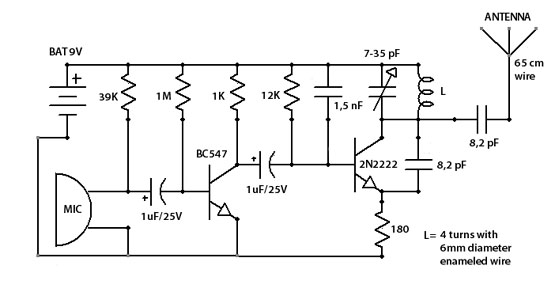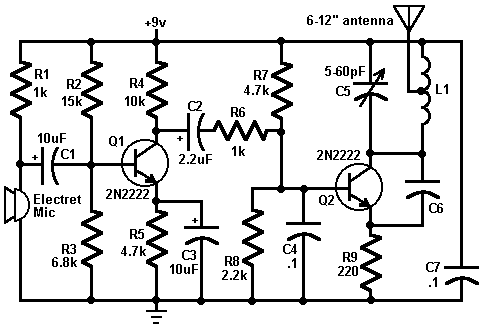
Sensitive FM Transmitter Bug

This simple-to-assemble FM transmitter can effectively transmit voice over a remarkably long distance. A tuning trimmer is included to facilitate signal reception on nearby radios. The transmitter operates within a frequency range of 88-108 MHz and has a maximum current consumption of 30 mA. It can be powered using a 9-volt battery or connected to a power supply providing 9-12 volts. This device is capable of picking up even faint sounds, such as a low whisper or the sound of breathing, from a considerable distance away, making it an excellent piece of equipment for covert audio transmission.
The FM transmitter circuit typically consists of several key components, including an oscillator, modulator, and antenna. The oscillator generates a carrier frequency within the designated range of 88-108 MHz. This is often achieved using a transistor-based oscillator circuit, which can be tuned by adjusting the trimmer capacitor.
The modulator section is responsible for superimposing the audio signal onto the carrier frequency. This is generally accomplished using a microphone connected to the circuit, which converts sound waves into an electrical signal. The modulated signal is then amplified before being sent to the antenna.
The antenna plays a critical role in radiating the transmitted signal into the environment. A simple wire antenna can be used, typically cut to a length that is a quarter wavelength of the operating frequency for optimal performance.
Power supply considerations are also essential. The transmitter can operate effectively with a 9-volt battery or from an external power supply that provides a voltage within the range of 9-12 volts. Care should be taken to ensure that the power supply can deliver sufficient current without exceeding the maximum consumption of 30 mA to avoid circuit damage.
The compact design of this FM transmitter makes it suitable for various applications, particularly in situations requiring discreet audio transmission. Its ability to capture faint sounds enhances its utility in surveillance or monitoring scenarios, where clarity and range are vital. Proper assembly and tuning of the circuit will yield a reliable and effective FM transmitter capable of transmitting audio over significant distances.This easy to build FM transmitter bug can transmit voice to exceptionally good range. Tune trimmer to hear the signal to your near radio. Transmitter frequency range is 88-108 MHz. Max current consumption is 30mA. You can power the fm transmitter bug with a 9Volt Battery, or you can plug a power supply to feed in 9-12 Volts. That bug will pick even a low whisper or even the sound of a breath well far from the microphone. Great spy transmitter equipment 🔗 External reference
The FM transmitter circuit typically consists of several key components, including an oscillator, modulator, and antenna. The oscillator generates a carrier frequency within the designated range of 88-108 MHz. This is often achieved using a transistor-based oscillator circuit, which can be tuned by adjusting the trimmer capacitor.
The modulator section is responsible for superimposing the audio signal onto the carrier frequency. This is generally accomplished using a microphone connected to the circuit, which converts sound waves into an electrical signal. The modulated signal is then amplified before being sent to the antenna.
The antenna plays a critical role in radiating the transmitted signal into the environment. A simple wire antenna can be used, typically cut to a length that is a quarter wavelength of the operating frequency for optimal performance.
Power supply considerations are also essential. The transmitter can operate effectively with a 9-volt battery or from an external power supply that provides a voltage within the range of 9-12 volts. Care should be taken to ensure that the power supply can deliver sufficient current without exceeding the maximum consumption of 30 mA to avoid circuit damage.
The compact design of this FM transmitter makes it suitable for various applications, particularly in situations requiring discreet audio transmission. Its ability to capture faint sounds enhances its utility in surveillance or monitoring scenarios, where clarity and range are vital. Proper assembly and tuning of the circuit will yield a reliable and effective FM transmitter capable of transmitting audio over significant distances.This easy to build FM transmitter bug can transmit voice to exceptionally good range. Tune trimmer to hear the signal to your near radio. Transmitter frequency range is 88-108 MHz. Max current consumption is 30mA. You can power the fm transmitter bug with a 9Volt Battery, or you can plug a power supply to feed in 9-12 Volts. That bug will pick even a low whisper or even the sound of a breath well far from the microphone. Great spy transmitter equipment 🔗 External reference





